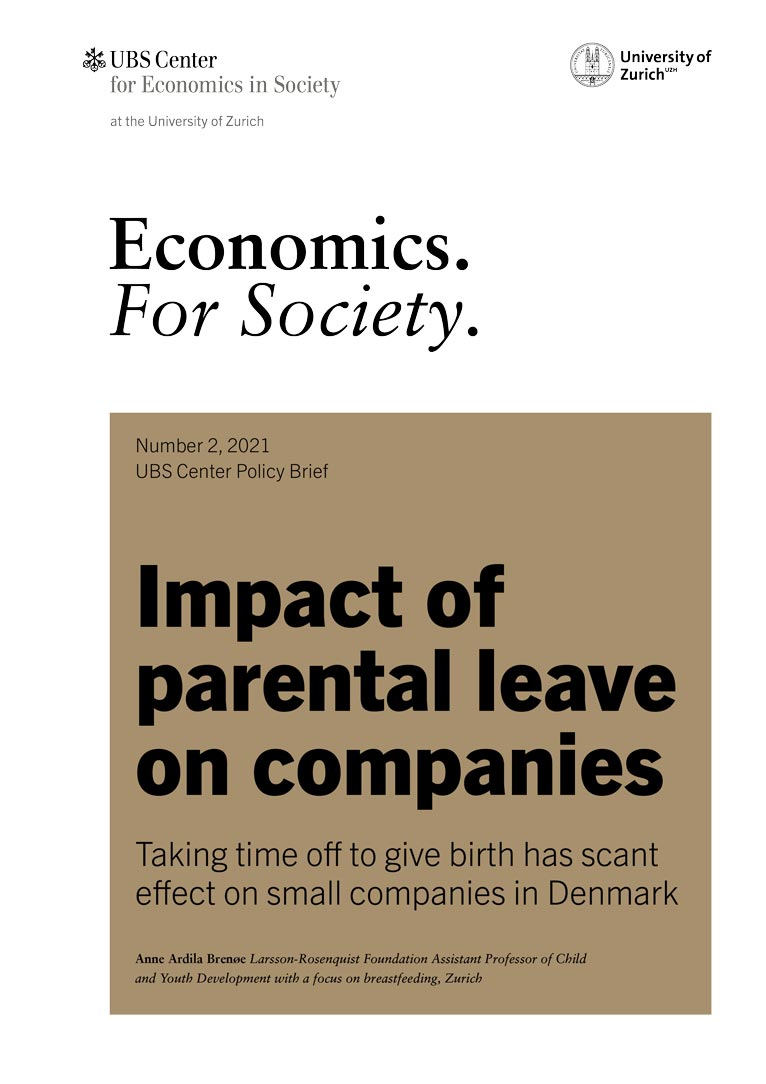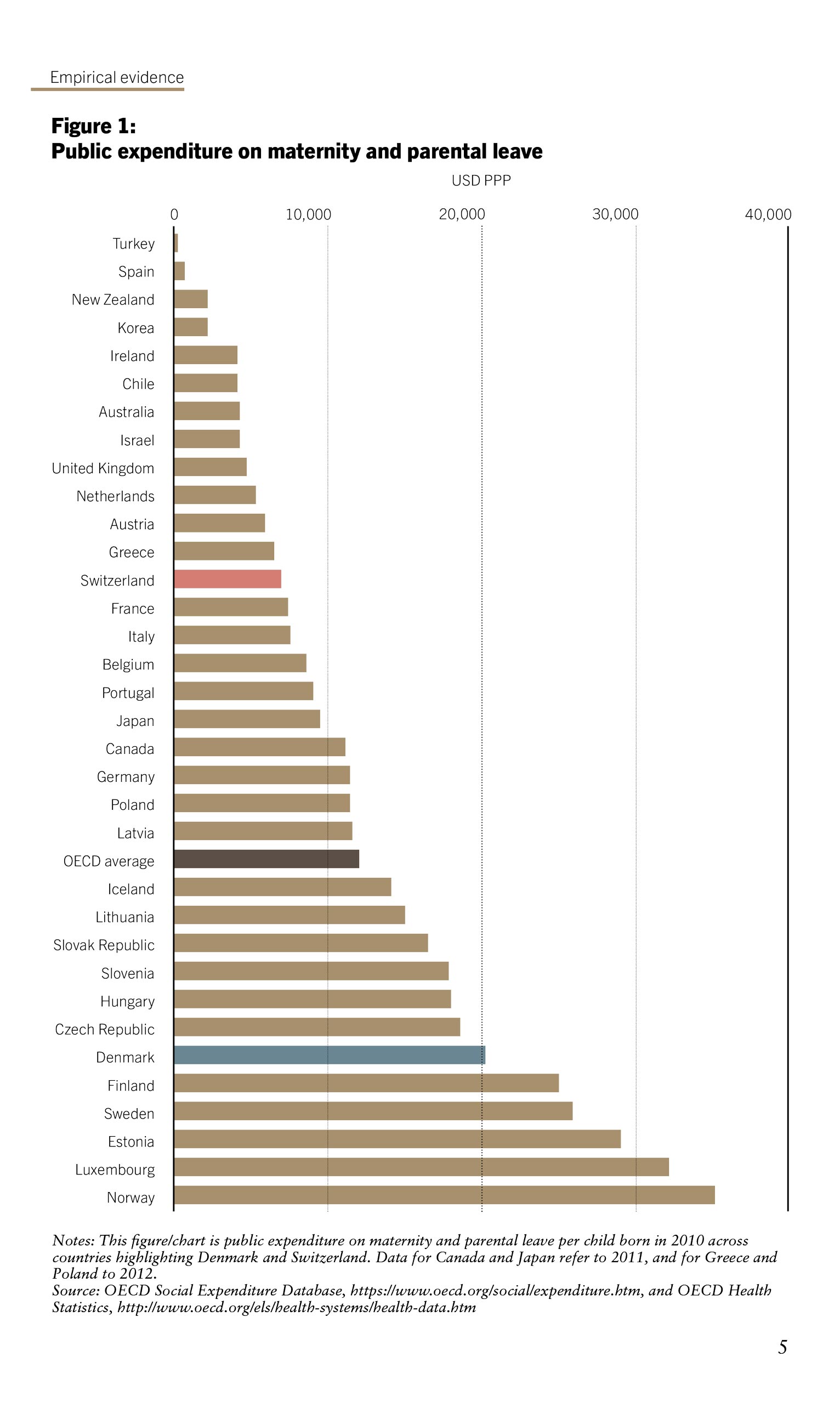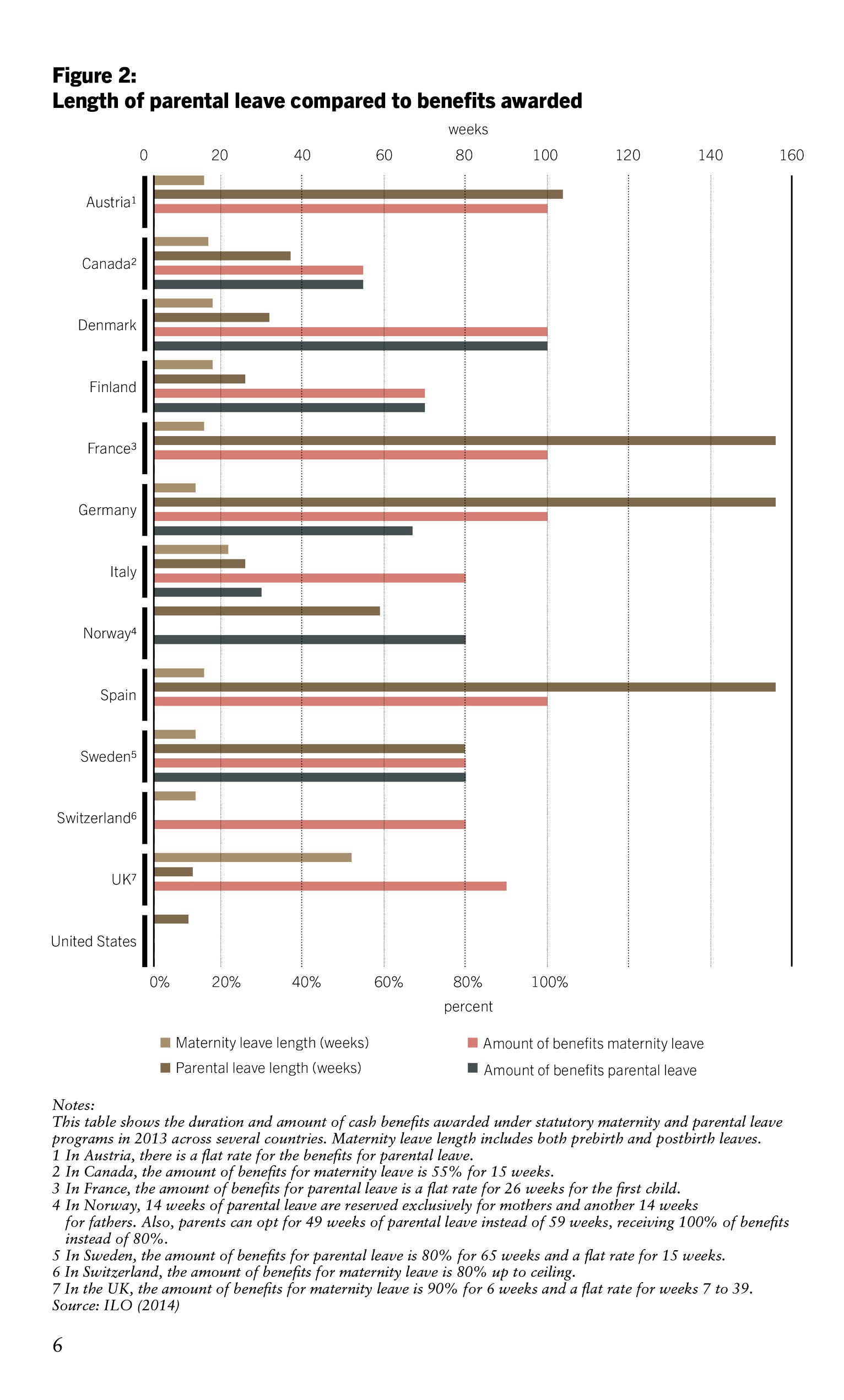2
Video summary
In a nutshell
Most of the existing evidence on the effectiveness of family leave policies stems from research on the impact on the families concerned – mothers, fathers, and their offspring – rather than the effects and costs on employers or fellow workers. By contrast, this policy brief examines the consequences of a female worker giving birth and taking parental leave on her employer and co-workers. Focusing on Denmark, a wealthy country with generous parental leave benefits, it shows there is little evidence of negative effects on either the employing company or co-workers. Output, labor costs, profitability, and company survival are largely unchanged. While co-workers experience temporary increases in hours, earnings, and the likelihood of retention, there are no significant alterations in their workplace well-being (as measured by sick days). This limited impact is due to most companies’ ability to compensate for parental leave by hiring temporary staff and raising other workers’ hours. Parental leave may, however, have negative effects on a small subset of companies who are less able to use existing staff to compensate.
Most of the existing evidence on the effectiveness of family leave policies stems from research on the impact on the families concerned – mothers, fathers, and their offspring – rather than the effects and costs on employers or fellow workers. By contrast, this policy brief examines the consequences of a female worker giving birth and taking parental leave on her employer and co-workers. Focusing on Denmark, a wealthy country with generous parental leave benefits, it shows there is little evidence of negative effects on either the employing company or co-workers. Output, labor costs, profitability, and company survival are largely unchanged. While co-workers experience temporary increases in hours, earnings, and the likelihood of retention, there are no significant alterations in their workplace well-being (as measured by sick days). This limited impact is due to most companies’ ability to compensate for parental leave by hiring temporary staff and raising other workers’ hours. Parental leave may, however, have negative effects on a small subset of companies who are less able to use existing staff to compensate.
Opportunities for action
1
The example of Denmark demonstrates that parental leave has no negative impact on firms’ output, gross profit, closure or on existing workers’ sick days. This is despite the fact that a new mother typically takes almost 40 weeks of job-protected leave with wage replacement. In Switzerland, for example, mothers can only take 14 weeks of paid maternity leave.
2
The worker’s absence due to parental leave can in part be offset by the additional commitment of existing workers. However, especially for smaller companies, good preparation is crucial as they generally have a smaller resource base to compensate for parental leave.
3
Because of the nature of the worker absence, companies can reduce costs by planning ahead, e.g., by reducing worker turnover. Early announcement of the future absence helps to prepare the company optimally for the changeover. A regulation like in Denmark to announce the pregnancy at least three months before birth is therefore desirable.
1
The example of Denmark demonstrates that parental leave has no negative impact on firms’ output, gross profit, closure or on existing workers’ sick days. This is despite the fact that a new mother typically takes almost 40 weeks of job-protected leave with wage replacement. In Switzerland, for example, mothers can only take 14 weeks of paid maternity leave.
2
The worker’s absence due to parental leave can in part be offset by the additional commitment of existing workers. However, especially for smaller companies, good preparation is crucial as they generally have a smaller resource base to compensate for parental leave.

What the data shows
While many of these programs benefit mother and their children, critics argue such absences can impose substantial costs on employers, including wage replacement benefits, as well as indirect costs such as for recruiting and training substitutes. Ultimately, such perceived burdens could make employers more reluctant to recruit and promote women of childbearing age.
In reality, the detailed research showed that the costs of parental leave are negligible both for companies and coworkers. Companies experiencing a worker on parental leave are generally good at compensating for the absent worker by redistributing work among other workers and/or by hiring temporary workers to fill any gaps. Overall, we do not find any significant effects of having a worker on parental leave on workers’ output, gross profit, and closure, or on existing employees’ sick days.
A female worker in a small Danish company who becomes pregnant and gives birth takes about nine and a half months of parental leave. To compensate for this substantial loss of labor input, employers temporarily hire more workers and slightly raise the retention rates and working hours for remaining workers – particularly those performing similar functions to the person on parental leave.
When one percent of the workforce gives birth and goes on leave, existing coworkers’ hours increase by 0.10 percent in the event year.
Additional cost burdens were only minimal. After taking into account reimbursement from the Government (UI benefits) and the parental leave fund, there was no significant increase to the company’s total wage bill.
Nor was there any notable deterioration in the company’s performance. The impact of the absence on fellow workers was also negligible.
However, the research did suggest some companies faced negative adjustment costs. A small number of companies that had no direct replacement for the worker on leave were constrained in how to adjust, as they could not just raise the hours of workers in similar occupations as the woman on leave. Accordingly, this small group of companies seemed to experience some negative effects of having a worker on parental leave, as they seemed to have a harder time to hire a replacement worker.
While true that absences due to parental leave differ from most other worker absences in being highly anticipated, giving companies more scope for planning, the impact for this small number of companies highlighted the importance of companies’ general good ability to adjust their labor inputs when having a worker on leave. Even if the costs are negligible overall, parental leave can be burdensome for some particularly vulnerable employers, while harmless for the overwhelming majority.
This UBS Center Policy Brief summarizes “Is Parental Leave Costly for Firms and Coworkers?” by Anne A. Brenøe, Serena P. Canaan, Nikolay A. Harmon, and Heather N. Royer. Forthcoming.
While many of these programs benefit mother and their children, critics argue such absences can impose substantial costs on employers, including wage replacement benefits, as well as indirect costs such as for recruiting and training substitutes. Ultimately, such perceived burdens could make employers more reluctant to recruit and promote women of childbearing age.
In reality, the detailed research showed that the costs of parental leave are negligible both for companies and coworkers. Companies experiencing a worker on parental leave are generally good at compensating for the absent worker by redistributing work among other workers and/or by hiring temporary workers to fill any gaps. Overall, we do not find any significant effects of having a worker on parental leave on workers’ output, gross profit, and closure, or on existing employees’ sick days.
Callouts
In detail
Parental leave for workers around childbirth is common in high-income economies. Strangely, however, little research has been conducted into the impact of such temporary disruptions on the performance of the employer concerned. While large companies may be expected to adapt to such absences largely unnoticed, smaller employers with fewer than 30 workers could suffer significant inconvenience and negative consequences. Indeed, public debate about the possible negative impact of parental leave has generally focused on smaller companies.
The theoretical background
Economic theory suggests that, if labor markets are frictionless and competitive, the employer would be able to substitute any lost labor input with an equivalent worker without incurring any additional costs. As labor is replaced at the market rate, no effect on fellow workers or the company output should be expected. Assuming employers suffer no costs related to paid leave, company costs (and thereby profits) should also be unaffected.
In reality, expensive and time-consuming searches, or other frictions, make such predictions much more nuanced. The affected company may not be able to replace the absent worker perfectly or may only be able to do so with a lag or after suffering extra expenses. If the company fails to replace the lost worker immediately, fellow workers’ productivity will change, depending on whether they are complements or substitutes in the production relative to the lost worker.
Fellow workers who are substitutes may witness a rise in productivity. The opposite would apply to those who are complements. Depending on how wages and employment are determined, such changes in productivity would imply shifts in co-workers’ wages, hours, and/or unemployment risk.
For the company itself, output would decrease if the absent worker were not replaced immediately, while profits would tend to fall due either to lower output or higher costs. In extremis, a company with the option to exit the market in response to lower profits could end up closing and laying off its entire workforce. In other words, if the labor market is characterized by frictions, the absence of one worker could cause significant damage to the company. Despite considerable policy relevance, direct estimates of the effects of parental leave on employers and co-workers are scarce.
Of course, certain factors mitigate such risks. Parental leave is highly anticipated (compared with many other causes of worker absence, such as sickness or death) and companies can plan well ahead. In Denmark, expectant mothers are required to announce their pregnancy to employers at least three months before their due date (though women commonly announce their impending pregnancy up to six months before their due date). This prior notice should make it much easier for employers to plan ahead, preparing for either direct replacement or necessary advance training. Parental leave is also temporary, with a specific return date. That means employers may be able to accelerate, or postpone, tasks where the worker going on leave plays a crucial role and is thereby harder to replace. The temporary nature of the leave may also constrain the types of adjustments companies can make; for example, downward wage-rigidity makes temporary wage changes impractical.
Parental leave is also relatively common compared with some other types of worker absence. So employers may be familiar with the details of the system and with such absences. That implies parental leave may be easier to plan for than some other types of worker absence.
The legislative context
Danish parental leave comprises two elements: a wage replacement component covering a specified number of weeks at a specified rate; and a job protection element during the leave period. The job protection means that workers who go on leave are guaranteed to be able to return to their job at the end of their leave (although there are certain exceptions).
At a minimum, all women are eligible to receive government-provided wage replacement equal to the maximum level of Danish unemployment insurance (UI) benefits during the entire 50 weeks of leave. On top of this, most employment contracts in Denmark offer some period of fully paid leave during which the employer simply continues to pay the worker her wage. During periods of fully paid leave, companies are directly reimbursed for the wages paid to workers on leave in two ways. First, the employer receives the government-provided wage replacement equal to the UI benefits (see Figure 1 for public expenditure on maternity and parental leaves per live birth). Second, companies paying wages to workers on leave qualify for reimbursement from one of several semi-private “parental leave funds” to which all employers contribute regardless of the gender and age composition of their workforce.
Most European countries have similar schemes, offering mothers 14 to 18 weeks of maternity leave at between 80 and 100 percent of normal pay (Figure 2). Most additionally provide parental leave that both parents can share, though the length and extent of benefits received vary substantially. On average, Denmark offers shorter shared parental leave (32 weeks) than many European counterparts, but comparatively high earnings replacement during that period. The country’s system of encouraging employers to offer paid leave and then reimbursing them is unusual, as most countries offer wage replacements funded and paid directly by their social insurance schemes.
A word about methodology
The main reason why there has been so little research on the impact of parental leave on employers and fellow workers stems from the need for comprehensive data linking company and worker outcomes to information on fertility and leave taking. Identifying casual effects is an extra challenge.
In the research summarized here, the impact of a woman’s giving birth and taking leave was studied in terms of its effect on companies’ demand for labor, costs, overall performance, and on co-workers’ labor outcomes (in terms of hours, retention, and earnings), where companies were reimbursed for the costs associated with wage replacement benefits during parental leave. These adjustments appear very effective in compensating for the worker on leave.
Sophisticated statistical tools allowed comparisons to be made between companies where a female worker gave birth and took parental leave and a control group of comparable companies with a female worker who did not give birth over the same time period.
The study used detailed administrative data on Danish companies and workers for the period 2001 to 2013. The information on employment relationships came from annual administrative data company pension contributions.
Information on company performance was calculated on the basis of the value-added tax returns where the reporting of total sales and purchases is obligatory if the revenue exceeds a defined value. Gross profitability was proxied by subtracting purchases and total wages (excluding leave) from total sales.
The female workers analyzed for both the treatment and control groups were limited to women who had been at the firm for at least one year and who were between 19 and 33 years in the baseline year, i.e., two years before the potential childbirth.
Parental leave for workers around childbirth is common in high-income economies. Strangely, however, little research has been conducted into the impact of such temporary disruptions on the performance of the employer concerned. While large companies may be expected to adapt to such absences largely unnoticed, smaller employers with fewer than 30 workers could suffer significant inconvenience and negative consequences. Indeed, public debate about the possible negative impact of parental leave has generally focused on smaller companies.
The theoretical background
Economic theory suggests that, if labor markets are frictionless and competitive, the employer would be able to substitute any lost labor input with an equivalent worker without incurring any additional costs. As labor is replaced at the market rate, no effect on fellow workers or the company output should be expected. Assuming employers suffer no costs related to paid leave, company costs (and thereby profits) should also be unaffected.


Further reading
Ginja, Rita, Arizo Karimi, and Pengpeng Xiao. 2021 Employer Responses to Family Leave Programs, IZA Discussion Paper, No. 13833.
Huebener, Matthias, Jonas Jessen, Daniel Kuehnle, and Michael Oberfichtner. 2021 A Firm-Side Perspective on Parental Leave, NBER Working Paper, No. 14478.
Olivetti, Claudia and Barbara Petrongolo. 2017 The Economic Consequences of Family Policies: Lessons from a Century of Legislation in High-Income Countries, Journal of Economic Perspectives, 31(1), 205-30.
Rossin-Slater, Maya. 2019 Maternity and Family Leave Policy. In: Averett, Susan L., Laura M. Argys, and Saul D. Hoffman (Eds.), Oxford Handbook on the Economics of Women, New York: Oxford University Press.
Author
Anne Ardila Brenøe is an Assistant Professor at the Department of Economics and Research Director of the LRF Center for Economics of Breastfeeding at the University of Zurich. Her primary research interests are in applied microeconomics. In particular, she is interested in labor economics, economics of education, and child development.
Anne Ardila Brenøe is an Assistant Professor at the Department of Economics and Research Director of the LRF Center for Economics of Breastfeeding at the University of Zurich. Her primary research interests are in applied microeconomics. In particular, she is interested in labor economics, economics of education, and child development.